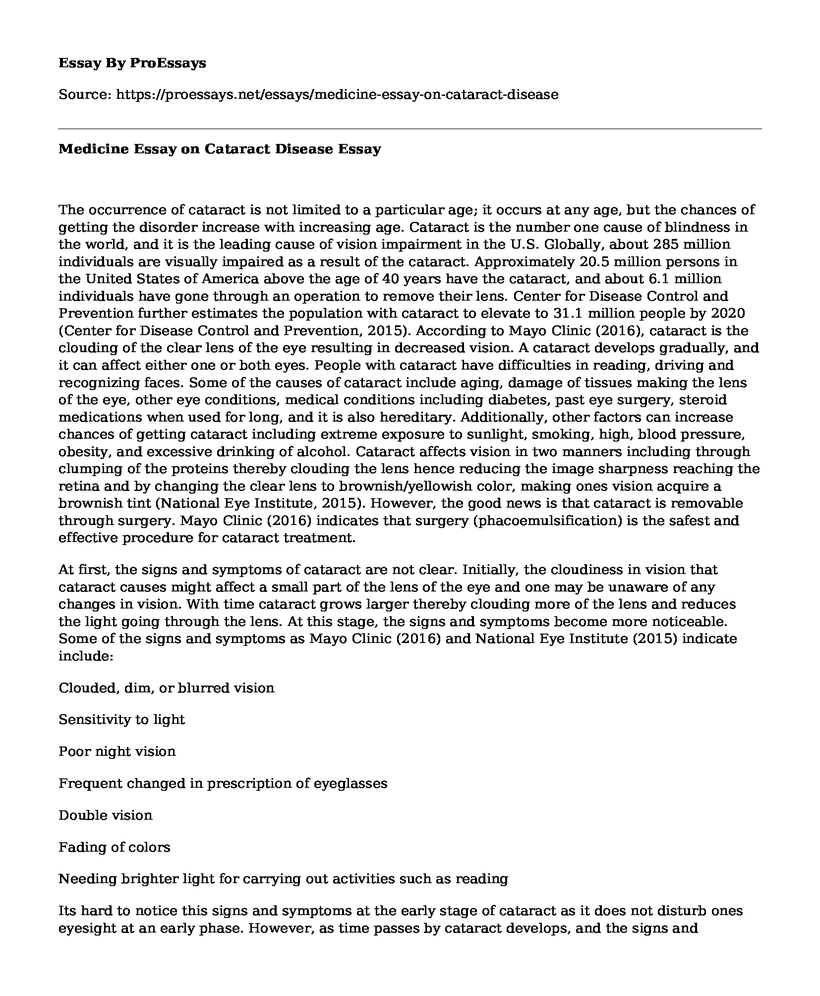The occurrence of cataract is not limited to a particular age; it occurs at any age, but the chances of getting the disorder increase with increasing age. Cataract is the number one cause of blindness in the world, and it is the leading cause of vision impairment in the U.S. Globally, about 285 million individuals are visually impaired as a result of the cataract. Approximately 20.5 million persons in the United States of America above the age of 40 years have the cataract, and about 6.1 million individuals have gone through an operation to remove their lens. Center for Disease Control and Prevention further estimates the population with cataract to elevate to 31.1 million people by 2020 (Center for Disease Control and Prevention, 2015). According to Mayo Clinic (2016), cataract is the clouding of the clear lens of the eye resulting in decreased vision. A cataract develops gradually, and it can affect either one or both eyes. People with cataract have difficulties in reading, driving and recognizing faces. Some of the causes of cataract include aging, damage of tissues making the lens of the eye, other eye conditions, medical conditions including diabetes, past eye surgery, steroid medications when used for long, and it is also hereditary. Additionally, other factors can increase chances of getting cataract including extreme exposure to sunlight, smoking, high, blood pressure, obesity, and excessive drinking of alcohol. Cataract affects vision in two manners including through clumping of the proteins thereby clouding the lens hence reducing the image sharpness reaching the retina and by changing the clear lens to brownish/yellowish color, making ones vision acquire a brownish tint (National Eye Institute, 2015). However, the good news is that cataract is removable through surgery. Mayo Clinic (2016) indicates that surgery (phacoemulsification) is the safest and effective procedure for cataract treatment.
At first, the signs and symptoms of cataract are not clear. Initially, the cloudiness in vision that cataract causes might affect a small part of the lens of the eye and one may be unaware of any changes in vision. With time cataract grows larger thereby clouding more of the lens and reduces the light going through the lens. At this stage, the signs and symptoms become more noticeable. Some of the signs and symptoms as Mayo Clinic (2016) and National Eye Institute (2015) indicate include:
Clouded, dim, or blurred vision
Sensitivity to light
Poor night vision
Frequent changed in prescription of eyeglasses
Double vision
Fading of colors
Needing brighter light for carrying out activities such as reading
Its hard to notice this signs and symptoms at the early stage of cataract as it does not disturb ones eyesight at an early phase. However, as time passes by cataract develops, and the signs and symptoms become noticeable as it interferes with ones vision (Mayo Clinic, 2016). It is advisable for one to seek eye examination as soon as changes in vision get noticeable.
In conclusion, cataract is clouding of the clear lens of the eye, and it affects approximately 285 million people worldwide. Aging, eye injury, smoking, drinking and steroids medications are the risk factors for cataract, and the signs and symptoms become noticeable with advancing cataracts, and they include blurred vision, double vision, fading colors among others. To avoid cataract avoid some of the risk factors including quitting smoking and drinking, manage health problems and have a healthy diet always. Most importantly, have periodic eye check.
References
Center for Disease Control and Prevention. (2015, September 29). Common Eye Disorders. Retrieved June 06, 2017, from https://www.cdc.gov/visionhealth/basics/ced/index.html
Mayo Clinic. (2016, August 21). Cataracts. Retrieved June 06, 2017, from http://www.mayoclinic.org/diseases-conditions/cataracts/home/ovc-20215123
National Eye Institute. (2015, September). Facts about cataract. National Institute of Health. Retrieved June 06, 2017, from https://nei.nih.gov/health/cataract/cataract_facts
Cite this page
Medicine Essay on Cataract Disease. (2021, Jun 23). Retrieved from https://proessays.net/essays/medicine-essay-on-cataract-disease
If you are the original author of this essay and no longer wish to have it published on the ProEssays website, please click below to request its removal:
- Promoting Health and Wellness in Children Essay
- Social Media and HIPAA Paper Example
- Paper Example on M.K.'s Chronic Bronchitis: A Case of Smoking-Induced Inflammation.
- Essay on Antineoplastic Drugs: Types and Uses in Cancer Treatment
- Informatics Technology: Revolutionizing Nursing Care & Health Outcomes - Essay Sample
- Essay Example on Stop Smoking & Radon Pollution: Reduce Health Hazards
- Essay Example on My Father's Terminal Cancer: A Tragic Tale







